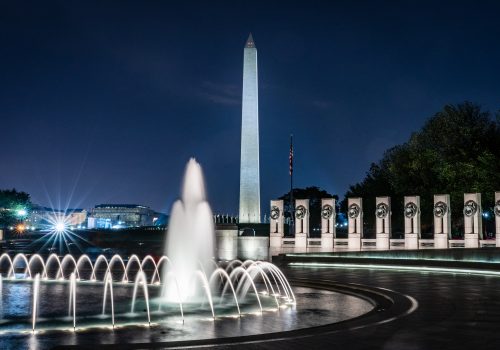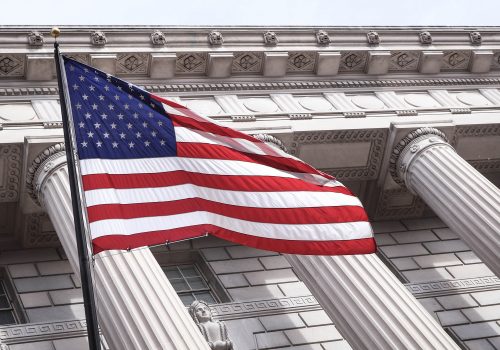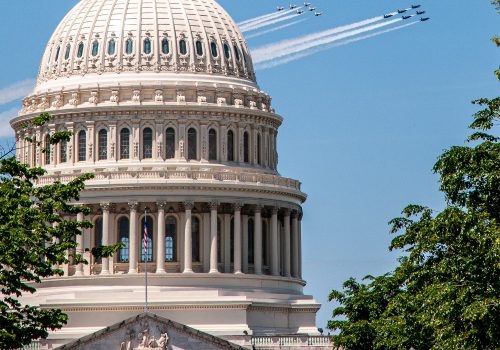I. Introduction
This chapter is part of a larger report—Economic might, national security, and the future of American statecraft. Download the full report using the button below.
The COVID-19 crisis and the resulting economic devastation have fueled already growing concerns about the state of the U.S.-led world order.1See, e.g., Kurt M. Campbell and Rush Doshi, “The Coronavirus Could Reshape Global Order,” Foreign Affairs, March 18, 2020, https://www.foreignaffairs.com/articles/china/2020-03-18/coronavirus-could-reshape-global-order; and Richard Haas, “The Pandemic Will Accelerate History Rather than Reshape It,” Foreign Affairs, April 7, 2020, https://www.foreignaffairs.com/articles/united-states/2020-04-07/pandemic-will-accelerate-history-rather-reshape-it. For the past decade, public figures have raised concerns about the rise of China,2This perception is most notably captured in the “Thucydides Trap” concept, popularized by Graham Allison in, among others, Graham Allison, Destined for War: Can America and China Escape Thucydides’s Trap? (New York: Houghton Mifflin Harcourt, 2017). the erosion of the American dream,3See, e.g., Josh Hawley, “Speech at the National Conservatism Conference,” July 18, 2019, https://www.hawley.senate.gov/senator-josh-hawleys-speech-national-conservatism-conference. the perceived failures of American leadership,4See, e.g., Robert Kagan, “The Cost of American Retreat,” Wall Street Journal, Sept. 7, 2018, https://www.wsj.com/articles/thecost-of-american-retreat-1536330449. and America’s relative loss of power.5See, e.g., Fareed Zakaria, The Post-American World (New York: W. W. Norton, 2009). Now, suffering through a tragic international crisis, it is only natural that people might wonder what the future holds. Whether one agrees with these concerns or not, it is undeniable that many Americans are uneasy about their country’s future.6A Pew poll, released in March 2019, reported that 60 percent of Americans surveyed thought America’s global status would decline in the coming decades. Kim Parker, Rich Morin, and Juliana Menasce Horowitz, “Looking to the Future, Public Sees an America in Decline on Many Fronts,” Pew Research Center, March 21, 2019, https://www.pewsocialtrends.org/2019/03/21/public-sees-an-america-in-decline-on-many-fronts/.
The reality of American power is complicated. By most measures, the United States still enjoys preeminence: It maintains the world’s most powerful military and is the global leader in technological development and innovation.7Scientific and technological expertise are leading sources of national power in the modern age. See, Ashley J. Tellis et al., Measuring National Power in the Postindustrial Age (Santa Monica, CA: RAND, 2000). It possesses unrivaled structural power, due both to its reserve currency and to America’s role in having shaped the principles of the global order and of international institutions.8Hal Brands describes the benefits America’s leadership in international institutions and guiding their underlying principles in, Hal Brands, Making the Unipolar Moment: U.S. Foreign Policy and the Rise of the Post-Cold War Order (Ithaca, NY: Cornell University Press, 2016). See also, Susan Strange, “The Persistent Myth of Lost Hegemony,” International Organization 41, no. 4 (Autumn, 1987): 551–74, https://doi.org/10.1017/S0020818300027600. Its network of like-minded allies and partners has endowed it with a unique ability to influence international affairs.9Joseph S. Nye Jr., Soft Power: The Means to Success in World Politics (New York: Public Affairs, 2004), 5. And a vibrant, strong economy has sustained the growth of American power,10Economic power does not lend itself to a simple formulation, but Samuel Huntington identified some of the elements of economic power, including dominance of markets, foreign exchange reserves, and a strong currency. Samuel P. Huntington, “The Economic Renewal of America,” National Interest, no. 27 (Spring 1992): 14–27. See also, William P. Bundy, “Elements of Power,” Foreign Affairs 56, no. 1 (October 1977): 1–26, https://www.jstor.org/stable/20039804. helped along by America’s unique political values and culture, and its standing as a symbol of democracy for the world.11Aaron L. Friedberg, “The Future of American Power,” Political Science Quarterly 109, no. 1 (Spring, 1994): 14–15.
At the same time, despite its many advantages, America currently faces serious headwinds, including high levels of debt, reduced economic mobility, political discord, and the emergence of a rising power.12See an online series of articles by Ray Dalio: “The Changing World Order,” https://www.principles.com/the-changing-world-order/. Even prior to the outbreak of the pandemic, America’s long-term spending commitments — including government and private debt, and pension and entitlement liabilities — totaled roughly 10 times the country’s GDP.13Greg Jensen and Jason Rogers, “The Crisis Is Accelerating the New Paradigm,” Bridgewater Associates, LP, March 30, 2020, https://www.bridgewater.com/research-library/daily-observations/the-crisis-is-accelerating-the-new-paradigm/. These developments, combined with growing political polarization,14See, e.g., Morris P. Fiorina, “The Democratic Distemper,” The Hoover Institution, May 14, 2019, https://www.hoover.org/research/democratic-distemper. have contributed to domestic unease, something the pandemic may worsen.15Decay can be seen as losing the sources of domestic dynamism or of cultural, ideological, or political power. See, e.g., Samuel Huntington’s review of the common arguments in, Samuel P. Huntington, “The U.S.: Decline or Renewal?” Foreign Affairs 67, no. 2 (Winter 1988): 76–96, https://www.jstor.org/stable/20043774. For more contemporary writing on decline and the perception of decline, see, e.g., Hal Brands, “American Grand Strategy in the Post-Cold War Era,” in New Directions in Strategic Thinking 2.0: ANU Strategic & Defence Studies Centre’s Golden Anniversary Conference Proceedings, ed. Russell W. Glenn (Acton, AU: Australian National University, 2018); and Ray Dalio, “The Changing World Order.”
The emergence of Asian economies as the drivers of global growth and the rise of China have also challenged American preeminence.16Ray Dalio, “The Changing World Order.” The Chinese Communist Party has proclaimed its plans to achieve great power primacy in the coming decades and has set about contesting American economic, military, structural, and cultural power.17Much has been written on China’s rise and geopolitical ambitions. See, e.g., H.R. McMaster, “How China Sees the World: And How We Should See China,” The Atlantic, May 2020, https://www.theatlantic.com/magazine/archive/2020/05/mcmaster-china-strategy/609088/; Ashley J. Tellis, “Pursuing Global Reach: China’s Not So Long March Toward Preeminence,” in Strategic Asia 2019: China’s Expanding Strategic Ambitions, ed. Ashley J. Tellis, Alison Szalwinski, and Michael Wills (Washington, DC: The National Bureau of Asian Research, 2019); Gary J. Schmitt, “The China Dream: America’s, China’s, and the Resulting Competition,” American Enterprise Institute, Jan. 18, 2019, https://www.aei.org/research-products/report/the-china-dream-americas-chinas-and-the-resulting-competition/; and Elizabeth C. Economy, The Third Revolution: Xi Jinping and the New Chinese State (Oxford: Oxford University Press, 2018). These developments in China raise the question: What is America’s plan for preserving its great power primacy?
America currently faces serious headwinds, including high levels of debt, reduced economic mobility, political discord, and the emergence of a rising power.
Some in America have gone through similar crises of confidence before,18For example, after the Soviet Union launched the Sputnik satellite and during the oil crisis of the 1970s. and each time the country has leveraged its unique strengths and capacities to recover and reach new heights.S19ee, e.g., H.R. McMaster, “Reclaiming America’s Strategic Confidence,” remarks at the Reagan National Defense Forum, Dec. 2, 2017, https://www.whitehouse.gov/briefings-statements/remarks-ltg-h-r-mcmaster-reagan-national-defense-forum-reclaiming-americas-strategic-confidence/; and Brands, Making the Unipolar Moment. How then, with these current headwinds, can the United States repeat that cycle of renewal? What unique strengths and asymmetric advantages can today’s leaders leverage to achieve that goal? That question is the primary focus of this article. To answer it, we examine the power that resides at the intersection of economics and national security and in doing so argue that America’s economic power underwrites its national security. We believe more can be done to sustain the country’s economic might and to leverage it in service of American primacy.
As the 2017 National Security Strategy succinctly puts it, “Economic security is national security.”20The National Security Strategy of the United States, The White House, December 2017, https://www.whitehouse.gov/wp-content/uploads/2017/12/NSS-Final-12-18-2017-0905.pdf. Driven by economic interdependence, the race to develop transformational technologies, and the ubiquity of cyberspace, national security and economics are converging. And that convergence is, according to Henry Farrell and Abraham Newman, “turning the global networked economy into a space of strategic actions, counteractions, threats, targeting, counter-targeting and decoupling.”21Henry Farrell and Abraham L. Newman, “Introducing a New Paper on ‘Weaponized Interdependence,’” Lawfare, July 31, 2019, https://www.lawfareblog.com/introducing-new-paper-weaponized-interdependence. This has, in some respects, been true for decades, but it is accelerating.
Other countries, including Russia and China, have recognized this reality and are already integrating their economic and security strategies in order to compete with the United States.22See, e.g., H.R. McMaster, “How China Sees the World.” However, over the past two decades the United States has been slow to adapt. The Trump administration’s recognition that America is engaged in great power competition and that China is its primary strategic competitor is a critical step in the right direction, as was the administration’s acknowledgment that “promoting American prosperity makes America more secure and advances American influence in the world.”23The National Security Strategy of the United States, 18. Yet, the United States still needs to improve and develop the structures and human capital that would best address those issues. And while the Trump administration’s forthcoming economic security strategy will likely outline valuable guidance, the United States has, for decades, lacked a clear agenda for coordinating its economic statecraft, domestic investments, and international partnerships to sustain American primacy.
We propose a principled policy to fund, coordinate, and incentivize domestic innovation and to attract and develop the people needed to do so.
We believe policymakers should take steps to integrate economic and national security policy. They can do this by adopting a three-part policy agenda to promote 1) innovation; 2) economic statecraft; and 3) international coordination. We propose a principled policy to fund, coordinate, and incentivize domestic innovation and to attract and develop the people needed to do so. We recommend policymakers evolve the country’s economic statecraft toolkit and develop a more targeted and sustainable strategy for its use. And we encourage coordination with allies and partners, as well as engagement in some multilateral structures. Doing so will make pro-innovation policies and economic statecraft far more effective.
To make this new agenda a reality, the U.S. government will also need new approaches to policymaking and managing talent. In this article, we explore potential process and institutional reforms that could overcome longstanding stovepipes and bureaucratic interests, and we recommend new talent management strategies to ensure the right people, with the right expertise and experience, are seated around the policymaking table.
The policy agenda presented here is an effort to further strengthen America’s economic dynamism and renew how the country builds and leverages its power in a rapidly changing and increasingly competitive landscape. There are other critical building blocks of American power — ranging from military readiness and modernization to the health of the democratic process — that deserve the attention of America’s leaders but are not addressed here. This agenda focuses on advancing America’s interests by, in the words of Sen. Marco Rubio, “rejuvenating our nation’s economic power.”24Marco Rubio, “American Industrial Policy and the Rise of China,” Remarks Delivered at the National Defense University, Dec. 10, 2019, republished in The American Mind, https://americanmind.org/essays/american-industrial-policy-and-the-rise-of-china/. Our goal is ambitious and targeted — to adapt U.S. policy and policymaking to ensure America’s economic, technological, and political leadership for decades to come.
Next:
Read the full report:
Image: Photo by Joshua Hoehne on Unsplash


